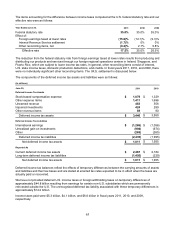Microsoft 2011 Annual Report Download - page 75
Download and view the complete annual report
Please find page 75 of the 2011 Microsoft annual report below. You can navigate through the pages in the report by either clicking on the pages listed below, or by using the keyword search tool below to find specific information within the annual report.
75
During the periods reported, the following stock option exercise activity occurred:
(In millions)
2011 2010 2009
Total intrinsic value of stock options exercised $ 222
$ 365 $ 48
Cash received from stock option exercises $ 1,954 $ 1,839 $ 88
Tax benefit realized from stock option exercises $ 77
$ 126 $ 12
Employee Stock Purchase Plan
We have an employee stock purchase plan for all eligible employees. Shares of our common stock may be
purchased by employees at three-month intervals at 90% of the fair market value on the last day of each three-
month period. Employees may purchase shares having a value not exceeding 15% of their gross compensation
during an offering period. Employees purchased the following shares during the periods presented:
(Shares in millions)
Y
ear Ended June 30, 2011 2010 2009
Shares purchased 20 20 24
Average price per share $ 22.98 $ 23.73 $ 20.13
At June 30, 2011, 43 million shares of our common stock were reserved for future issuance through the employee
stock purchase plan.
Savings Plan
We have a savings plan in the U.S. that qualifies under Section 401(k) of the Internal Revenue Code, and a
number of savings plans in international locations. Participating U.S. employees may contribute up to 50% of their
salary, but not more than statutory limits. We contribute fifty cents for each dollar a participant contributes in this
plan, with a maximum contribution of 3% of a participant’s earnings. Matching contributions for all plans were
$282 million, $275 million, and $262 million in fiscal years 2011, 2010, and 2009, respectively, and were
expensed as contributed. Matching contributions are invested proportionate to each participant’s voluntary
contributions in the investment options provided under the plan. Investment options in the U.S. plan include
Microsoft common stock, but neither participant nor our matching contributions are required to be invested in
Microsoft common stock.
NOTE 21 — SEGMENT INFORMATION AND GEOGRAPHIC DATA
In its operation of the business, management, including our chief operating decision maker, the Company’s Chief
Executive Officer, reviews certain financial information, including segmented internal profit and loss statements
prepared on a basis not consistent with U.S. GAAP. The segment information within this note is reported on that
basis. Our five segments are Windows & Windows Live Division; Server and Tools; Online Services Division;
Microsoft Business Division; and Entertainment and Devices Division.
Due to the integrated structure of our business, certain revenue earned and costs incurred by one segment may
benefit other segments. Revenue on certain contracts may be allocated among the segments based on the
relative value of the underlying products and services. Costs that are identifiable are allocated to the segments
that benefit to incent cross-collaboration among our segments so that one segment is not solely burdened by the
cost of a mutually beneficial activity. Allocated costs may include those relating to development and marketing of
products and services from which multiple segments benefit, or those costs relating to services performed by one
segment on behalf of other segments. Each allocation is measured differently based on the specific facts and
circumstances of the costs being allocated.
In addition, certain costs incurred at a corporate level that are identifiable and that benefit our segments are
allocated to them. These allocated costs include costs of: field selling; employee benefits; shared facilities
services; and customer service and support. Each allocation is measured differently based on the specific facts
and circumstances of the costs being allocated. Certain other corporate-level activity is not allocated to our
segments, including costs of: broad-based sales and marketing; product support services; human resources;
legal; finance; information technology; corporate development and procurement activities; research and
development; legal settlements and contingencies; and employee severance.






















